|
Trapping and Wildlife Conservation
Responsible management balances recreation and resources.
STORY BY BOB BLUETT
PHOTOS BY ADELE HODDE/BOB BLUETT
For many people, their first image of trapping was a Roadrunner cartoon and Wile E. Coyote gently pouring bird seed onto the trigger of a huge trap with teeth on its jaws.
It's fair to say most people, especially those growing up in an urban setting, have little to no exposure to trapping. Thus, misconceptions commonly arise.
Regulated hunting and trapping can reduce or prevent property damage caused by an overabundance of wildlife.
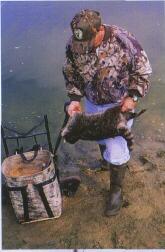
|
One misconception is that trapping threatens or endangers animal populations. This might have been the case 200 years ago, however, today's state, federal and international laws protect endangered and threatened species.
Twelve species defined as fur-bearing mammals may be trapped in Illinois. All are abundant, and wildlife biologists for the Department of Natural Resources are responsible for keeping them that way.
By monitoring wildlife populations, biologists detect changes in abundancy and adjust harvest regulations accordingly. Open seasons (times of the year when trapping is legal) occur during the fall and winter, preventing the possibility of capturing mothers with dependent young, and ensuring that pelts harvested by trappers are marketable.
Sales of trapping licences and habitat stamps support habitat restoration projects that benifit a wide variety of plants and animals.
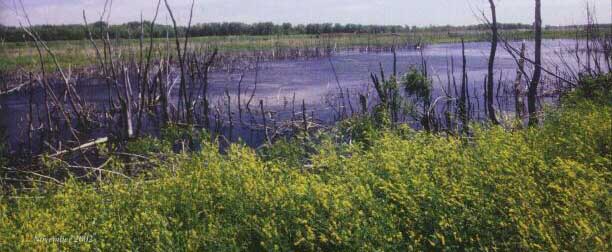
|
November 2002 5
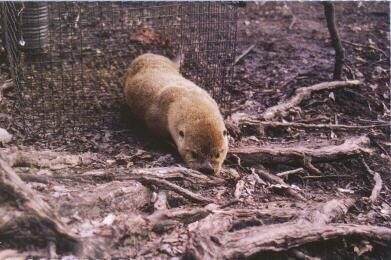
River otters have flourished after being captured in Louisiana with foothold traps and released in Illinois.
|
Bag limits are another tool for conducting responsible harvest programs. Illinois' badger season is a good example. A study conducted in the early 1990s revealed badgers were more common than thought, especially in the northern half of the state. Based on this information, the DNR opened a trapping season for badgers, but limited trappers in northern Illinois to two per person, per season. A more conservative limit of one per season was set for southern Illinois.
Trapping is Highly Regulated
Laws that keep wildlife from becoming endangered are the tip of the iceberg. Nearly two dozen laws set standards for animal welfare by limiting when, where and how animals are captured. Some date to the 1930s, when sizes of traps were first restricted.
About a quarter of a century ago, trapping organizations worked with DNR to make some sweeping changes in trapping regulations. They banned traps with teeth, required trappers to visit their sets daily, and took other steps to improve animal welfare and selectivity of trapping methods.
Foothold traps are the only effective tools for capturing foxes and coyotes. The use of small traps and those with wide or padded jaws reduces injuries.
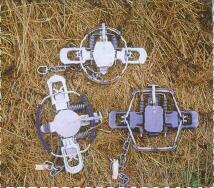
|
Attendance at trapper education courses was voluntary when the program was implemented in 1981. In 1985, successful completion of a course became mandatory for first-time trappers under 18 years of age. Recent updates to the student manual include the latest technologies for capturing animals efficiently and humanely.
Laws work best with accountability. When set in the field, traps must be marked with the owner's name and address. Trappers are required to obtain permission from landowners or tenants before trapping on their property. They must also obtain permission from anyone living within 100 yards of where a trap is set.
Such laws help ensure that trapping is conducted responsibly, in terms of both wildlife populations and individual animals.
Trapping Benefits Society
Trapping helps to maintain a balance between the needs of wildlife and those of people. This might seem heavy-handed to anyone who thinks we should let nature take its course. The truth is, in an environment with 12 million people and 21 million acres of cropland, sometimes nature needs a hand.
Species adapted to Illinois' altered landscape have prospered. Raccoon, opossum, coyote and beaver are probably more abundant now than when Europeans first arrived here.
Trapping seasons have been expanded to encourage the harvest of plentiful animals and help curb property damage. This is especially true in rural areas, where trapping animals for fur is a practical solution to problems, while making the most of an abundant resource. Trapping programs tailored to the needs of urban areas usually are
|
Pelts sold by Illinois hunters and trappers during the 2001-2002 season:
| |
Species | No. sold | Percent
taken by
trappers | Avg. value ($)
|
Muskrat
|
31,923
|
100
|
2.90
|
|
Mink
|
2,842
|
100
|
7.65
|
|
Raccoon
|
165,375
|
57
|
7.55
|
|
Opossum
|
5,633
|
21
|
1.15
|
|
Red fox
|
879
|
25
|
15.35
|
|
Gray fox
|
83
|
32
|
8.25
|
|
Beaver
|
6,853
|
100
|
8.35
|
|
Striped skunk
|
229
|
0
|
3.35
|
|
Weasel
|
24
|
100
|
0.80
|
|
Coyote
|
4,381
|
27
|
7.55
|
|
Badger
|
26
|
100
|
7.05
|
|
OutdoorIllinois 6
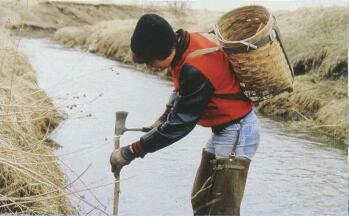
First-time trappers under the age of 18 must complete a trapper education course before purchasing a trapping license.
conducted under a different set of laws.
|
River otters released in Illinois from 1994-1997 were captured in Louisiana using small foothold traps. The 346 otters released are projected to result in 4,610 otters by 2005. Their status was upgraded from state endangered to state threatened in 1999. Endangered species experts will convene in 2004 to review the latest river otter information, and it seems likely otters will be removed from the state's list of threatened species.
In other parts of the United States, trapping is used to protect rare and endangered species, such as sea turtles, whooping cranes and least terns, by removing predators during nesting seasons.
Animals captured by trappers are used for a wide variety of products besides fur garments. Meat from raccoon, muskrat and beaver is edible. Castoreum from beaver is used in high-quality perfumes.
Little goes to waste. Fur buyers pay rendering plants to dispose of unused animal parts. These are "recycled" into products like pet foods, top-quality lubricants used in jet planes and in the manufacturing processes of paint, tires and soap.
Fees from sales of licenses and habitat stamps support conservation efforts that benefit all wildlife, not just those that are hunted and trapped. For example, nearly $200,000 in stamp revenues has supported 19 wetland restoration projects approved through the State Furbearer Fund program.
|
Available resources
For additional information on furbearers and trapping, contact the DNR Clearinghouse at clearing® dnrmail.state.il.us or phone (217) 782-7498 for free copies of Fur Hunting and Trapping in Illinois (brochure and videotape) or Furbearers of Illinois (poster).
Also available is the Ecology and Conservation of Illinois' Fur Resources website at http://www.inhs.uiuc.edu/dnr/fur.
|
Trapping benefits society by helping to control or prevent property damage, protect or restore rare species, conserve wildlife habitat and obtain a wide array of products for human use. DNR's policy on trapping reflects these values:
"The Department supports regulated trapping and efforts to address societal concerns through appropriate education, research, enforcement and regulatory programs. 'Such programs shall be designed to increase awareness and acceptance of trapping by seeking to enhance animal welfare while maintaining management capabilities and other benefits associated with this activity."
|
Bob Bluett is a certified wildlife biologist with the Illinois Department of Natural Resources. He coordinates wildlife damage management, research, monitoring and recovery programs for furbearing wildlife species.
|
|
DNR monitors wildlife populations and adjusts harvest seasons accordingly.
| 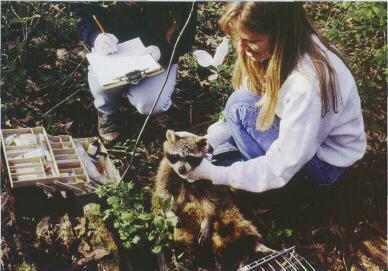
|
|
November 2002 7
|

